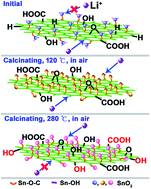A facile post-process method to enhance crystallinity and electrochemical properties of SnO2/rGO composites with three-dimensional hierarchically porous structure†
Abstract
In this work, three SnO2/reduced graphene oxide (SnO2/rGO) composites with a three-dimensional hierarchically porous structure were synthesized via freeze drying and different annealing temperatures in an air atmosphere. The results show that the crystallinity of SnO2 can be improved with increasing annealing temperature in air atmosphere, but the crystallinity quality of rGO presents a volcanic type change with increasing annealing temperature. The cyclic voltammetry curves indicate that the reaction of Li+ intercalation into SnO2 and rGO can only occur in the 120 °C sample, so that the cycling performance of the 120 °C sample is the best. Its initial discharge capacity is 1610 mA h g−1 at current densities of 0.5 A g−1. After 100 cycles, the specific discharge capacity is 429 mA h g−1. The XPS results reveal that SnO2 nanoparticles are anchored on the surface of rGO via Sn–O–C bonds. During the charge/discharge process, the volume expansion of SnO2 nanoparticles can be prevented through enhancing the crystallinity of ultra-small SnO2 nanoparticles (about 3.2 nm). This might pave the way for the commercial production of the SnO2/rGO electrode because these post-processing technologies are more easily implemented in industrial production.


 Please wait while we load your content...
Please wait while we load your content...